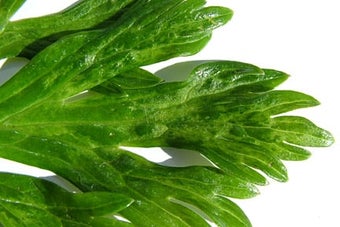
Quick facts
Common name - Tomato viruses
Scientific name - Various
Plants affected - Tomatoes
Main symptoms - Leaf distortion, stunted growth, marbling of fruit, reduced yield
Caused by - Viruses
Timing - At any time during growing season
What are tomato viruses?
More than 20 viruses affect tomatoes worldwide, causing a wide variety of mosaic patterns and distortions to the leaves, stunted growth and marbling patterns on the fruit.
The most common tomato viruses are:
- Tobacco mosaic virus (TMV)
- Tomato mosaic virus (ToMV)
- Tomato spotted wilt virus (TSWV)
- Pepino mosaic virus (PepMV)
- Cucumber mosaic virus (CMV)
For more on how these viruses are transmitted, see the Biology section below.
Symptoms
You may see the following symptoms:
- Stunted growth and reduced yield are common symptoms, especially when several viruses are present
- Mosaic patterns of lighter green on the leaves (TMV, ToMV, CMV, PepMV)
- Fern leaf, where the leaf blade is reduced in size to give a fern-like appearance (TMV, CMV, PepMV)
- Brown-streaked leaves (TMV)
- Young leaves curl downwards and become bronzed (TSWV)
- The leaf surface appears distorted and bubbly (PepMV)
- Dry set, when fruit fail to set (TMV)
- Fruit develop a bronzed, patchy appearance (TMV, ToMV)
- Fruit ripens unevenly with pale patches or marbling (TSWV, PepMV)
Stunting, distortion and fern leaf may also be caused by exposure to hormone weedkillers, to which tomatoes are very sensitive. These are volatile and can act from a distance, without direct contact. Providing the source is removed, plants usually recover, but they do not usually recover from virus infection.
Control
Non-chemical control
- It's recommended to remove plants with symptoms promptly, as they will be acting as a source of infection for other healthy tomato plants nearby
- After handling infected plants, wash hands and tools in hot soapy water. As an additional precaution, sterilise tools in the disinfectant Virkon S, obtainable from farm suppliers
- Avoid growing other susceptible plants in close proximity
- Cultivars with claimed resistance to TMV include ‘Cherry Wonder’, ‘Cumulus’, ‘Dombito’, ‘Dona’, ‘Estrella’, ‘Ida’, ‘Nimbus’, ‘Piranto’, ‘Shirley’ and ‘Sonatine’
Chemical control
There are no chemical controls. The use of insecticides to reduce aphid transmission is not practical for amateur gardeners.
Biology
Plant viruses are extremely minute infectious particles consisting of a protein coat and a core of nucleic acid. They have no means of self-dispersal, but rely on various vectors (including humans) to transmit them from infected to healthy plants. Once viruses penetrate into the plant cells they take over the cells’ nucleic acid and protein synthesis systems and ‘hijack’ them to produce more virus.
Viruses are frequently transmitted through propagated material but, depending on the virus, can also be transmitted via insect or mite vectors, pollen, mechanical transfer via contaminated hands and tools, or nematode vectors in the soil. Some viruses can be transmitted via seed, but generally these are a minority and therefore seed propagation is often a useful way to ensure virus free plant material.
Vectors
- CMV is vectored by aphids
- TSWV is vectored by thrips, especially the western flower thrips
- TMV is very easily spread mechanically on tools and fingers
- PepMV is mechanically transmitted, although seed transmission is possible
- TMV is occasionally transmitted via seed
Several of these viruses can infect other garden plants. CMV has a very wide range of hosts, not only among cucurbits. TMV also affects tobacco and potato. TSWV affects many plants in the tomato family (Solanaceae) and also gloxinias (Sinningia), arum lilies and dahlias.
PepMV was first detected in Europe in 1999. Although it is controlled by plant health regulations gardeners do not need to report suspected outbreaks, but should not save seed from affected plants for re-use. See the Defra Plant Health Portal for more information on symptoms.
A number of other non-indigenous viruses and viroids are a threat to tomato production in the UK. Details can be found in this Defra factsheet.





